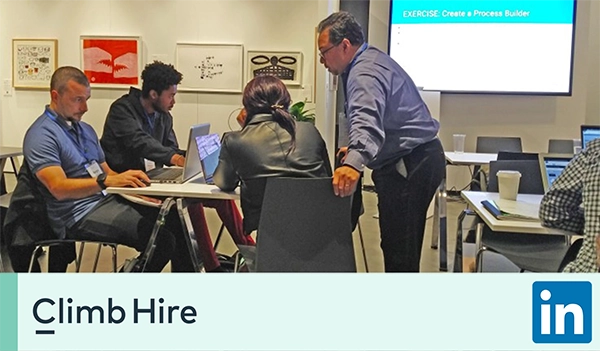By George Anders, Senior editor at large, LinkedIn. This article was originally published on LinkedIn.
If you’re an ambitious person who’s spent the past few years in blue-collar jobs to pay the bills, what could rocket you into a life-changing, high-paying career in tech?
Jessy Hernandez wants to make that leap. She has worked as a legal assistant, a store clerk, and even a cashier at In-N-Out Burgers. She has impressed her bosses at each stage with her initiative. But she hasn’t yet found a way to break through to something better.
So, twice a week, Hernandez brings her laptop to an unusual new version of night school. Along with about 30 other strivers like her, Hernandez is enrolled in Climb Hire, a program in downtown San Francisco that teaches non-technical people the ins and outs of Salesforce’s wildly popular customer-relationship software. The goal is to master everything needed to become administrators that keep Salesforce humming, round-the-clock, at big corporate installations.
Think of administrators as the air-traffic controllers of tech. They don’t attract the glory (or notoriety) of pilots or star software engineers. But they play an essential role in keeping everything running. There’s constant job-market demand for their skills. And in many parts of the country, fully certified Salesforce sys admins are earning more than $75,000 a year.
Climb Hire picks deeply motivated students who may lack a college degree (and may be earning as little as $25,000 a year) but who are determined to find a better path. Then it trains them with a curriculum that’s half about technology — and half about life.
One chunk of each session is devoted to what you’d expect anywhere: core technical skills associated with the Salesforce administrator role. Instructor Michael Orias, who has worked in tech for more than 25 years, takes students through a carefully laddered series of exercises. They know their way around dashboards and workflows. Transaction security policies do not fluster them. Not only do they win Salesforce approved badges for their expertise; they also qualify for “super-badges.”
The other half of Climb Hire’s classroom time, however, is deliberately non-technical. That’s when student focus on people skills, rather than computer processes. They role play with one another. They learn how to ace a job interview, how to strike up a conversation with strangers – and how to support one another with the social capital that often defines the difference between getting ahead or being left behind.
Look closely at high achievers’ careers, and you’ll see that strong social capital is just as important as technical skills. In fact, connections and an easy sense of self-assurance might be even more crucial, argues Climb Hire founder and chief executive Nitzan Pelman.
As she points out, a lot of tech-sector culture is based on the misguided belief that everyone worth hiring either went to elite schools or can match the everyday social dynamics of Harvard, Stanford and Berkeley graduates. Climb Hire aims to break down barriers by teaching non-traditional learners the sorts of “soft skills” that otherwise might create hidden barriers to getting hired or succeeding on the job.
I first met Pelman about a year ago, when she was working at LinkedIn as an entrepreneur in residence. Even then, she was a thoughtful – and unstoppable – champion of empowering people of all backgrounds to build their social connections. She started Climb Hire earlier this year. It has become its own standalone business, with core ownership and management that’s separate from LinkedIn, although the startup does use LinkedIn facilities to host its classes.
On a recent visit to Climb Hire’s classes, students received 1:1 attention from established tech-sector employees, who offered tips about how to make resumes and LinkedIn profiles sparkle. In Hernandez’s case, the first draft of her resume was packed with standard language from job descriptions. Phrases like “carried out the responsibilities of the job” were sprinkled throughout. The text made her sound like an adequate employee. It was hard to identify her sparkle.
We started chatting. “Did you win any sales contests?” I asked her, in connection with one job in retail. “Yes,” she replied, with shy pride. “Was there a cash prize?” Yes, there was. A few moments later, she had spruced up that section.
Reviewing her resume was like peeling drab paint from an elegant hardwood cabinet. She had completed difficult projects ahead of schedule. She had shown initiative in proposing ideas her bosses hadn’t thought about. She just needed to get those wins onto the page.
During a break, I asked Pelman how Hernandez was doing on the core Salesforce curriculum. “She’s one of our strongest students,” Pelman replied. “She was the first one to earn a super-badge.” On the whiteboard at the front of the class, however, four other students had written their names in large, Sharpie script, as winners of super badges. There wasn’t any sign of “Jessy Hernandez” in that section.
When Hernandez returned to her seat, I asked why her name wasn’t on the list. She shrugged, with a faint suggestion that perhaps it felt awkward to be boasting about one’s own accomplishments. “Jessy!” I replied. “I’d like you to do me a favor. Before this class is over, I’d like you to walk over to the board and put your name up there, where it belongs.”
She didn’t hesitate. She rose from her seat, walked the dozen or so steps to the white board, and picked up a black Sharpie. She paused a moment, looking for the best place to add her name. The only room was at the very top. A few moments later, a neatly scripted “Jessy” appeared on the board.

